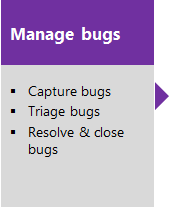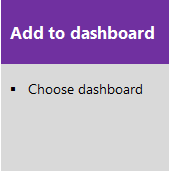Note
Access to this page requires authorization. You can try signing in or changing directories.
Access to this page requires authorization. You can try changing directories.
Azure DevOps Services | Azure DevOps Server | Azure DevOps Server 2022 | Azure DevOps Server 2020
The Capability Maturity Model Integration (CMMI) process provides work item types (WITs) you use to plan and track work, tests, feedback, and code reviews. When you create a project with the CMMI process, the project creates artifacts such as requirements, change requests, tasks, and bugs based on the CMMI framework. These artifacts help teams capture scope, monitor progress, and record engineering and review activities.
![]()
Teams use queries to list and filter work items so they can analyze progress and make data-driven decisions.
Note
- You can customize the work tracking system for your project by creating and customizing an inherited process and applying that process to your project. For more information, see Process customization and inherited processes.
- You can also customize a process template. For more information, see Default processes and process templates.
Note
- You can customize the work tracking system for your project by customizing an Inherited process or an On-premises XML process. For more information, see Process customization and inherited processes or On-premises XML process customization. The latest version of each process uploads automatically when you install or upgrade to the latest version of Azure DevOps Server. Other artifacts, such as SQL Server reports, are only available when you connect to a project. Other resource requirements apply.
- You can also customize a process template. For more information, see Default processes and process templates.
Plan and track work with CMMI
Teams plan projects by capturing features and requirements. When teams work in sprints, they create tasks and link them to requirements. Program managers link requirements to features to view rollups across teams. Teams track blocking problems with issues. For hands-on guidance, see CMMI process work item types and workflow.
The following image shows the essential flow for getting started. For more information, see Get started with Agile tools to plan and track work.
Select one of the following images to go to the linked article.
Note
A work item is a database record that contains the definition, assignment, priority, and state of work. Work item types define the template of fields, workflow, and form for each type. Work items can be linked to each other to support tracking dependencies, roll up of work, and reports.
List work items with queries
Use work item queries to list items by type—change requests, bugs, tasks, and requirements. Queries help you focus on current work, triage issues, and prepare for planning and reporting.
Note
When you create a new project, there's no longer a default set of Shared Queries. The definitions for Shared Queries were removed from the process template. For on-premises deployments, you can add them to a custom process template as described in Add work item queries to a process template.
View and run queries from the web portal or from the Team Explorer plug-in for Visual Studio. Modify a query using the query editor to apply different filter criteria and add queries to team dashboards.
Tips for shared queries
Enhance your workflow using the following tips:
- Add @Me as the value for the Assigned To field in a query clause to find work items assigned to you.
- Open the query editor to modify any query by adding criteria for a product area, iteration, or another field.
- Open a query in Excel to update fields of one or more work items and publish changes to the database.
- Create a pie-chart, column chart, or trend chart to visualize status or progress for flat-list queries.
- Create queries and folders under the My Queries area with standard access. To create queries and folders under Shared Queries, ensure you have the Contribute permission and at least Basic access. For more information, see Set permissions on queries.
Monitor progress
All processes—Agile, Scrum, and CMMI—support building status and trend charts and dashboards. Several charts populate automatically based on the Agile tools you use; these charts appear in the web portal.
Create light-weight charts
You can define a shared flat query and create a chart based on your tracking interests. Chart types include:
- status: pie, bar, column, stacked bar, and pivot
- trend: stacked area, line, and area
Select one of the following images to go to the linked article.
Analytics widgets and Power BI reports
The Analytics Service can answer quantitative questions about the past or present state of your projects. You can add Analytics widgets to a dashboard or use Power BI to create charts and reports.
For more information, see What is the Analytics Service?
SQL Server reports
If your project collection and project use SQL Server Analysis Services and Reporting Services, you can access many CMMI reports. For those reports to be useful, teams must perform activities such as defining build processes, linking work items to builds, and updating status and remaining work.
If you need to add reporting services or update reports to the latest versions, see Add reports to a project.
CMMI process versions
As the CMMI process template evolves, its version number changes. The template provides a version element that specifies major and minor versions. The following table maps template versions used by Azure DevOps on-premises releases; Azure Boards (cloud) always uses the latest template.
| Version | CMMI name | Major version |
|---|---|---|
| Azure DevOps Services Azure DevOps Server 2022 |
CMMI | 18 |
| Azure DevOps Server 2020 | CMMI | 17 |
For a summary of updates to on-premises process templates, see Release Notes for Azure DevOps Server.
Use the CMMI process effectively
Teams follow different practices and established processes. This guidance highlights activities relevant to using the CMMI process effectively.
- Learn about CMMI: Understand CMMI and its six capability levels.
- Manage projects: Get guidance on managing, planning, and coordinating software development and maintenance with the CMMI model.
- Explore engineering activities: Discover value-added activities for designing and building software products.
Use the CMMI template and guidance as part of a process improvement program and adapt them based on:
- Product type and history
- Project scale
- Team skills and backgrounds
- Accepted practices in your organization






